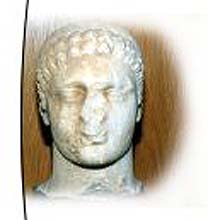Labranda
Labranda, is a holy area of Zeus Labraundos, is in ancient Karia (South-western Anatolia), 14 km to the north-east of Mylasa city to which it is affiliated.
The most ancient findings belong to the year 600 BC.The area that was used as holy area in the 6th and the 5th centuries and then as temple terrace consisted of a single, small, artificial terrace. A war took place in the holy area in 497 BC and Karia army has been defeated by the Persian army with its alliances.
 The 4th century BC is the most important period for the temple. At the times of the satraps named Mausolos (377 - 352 BC) and Idrieus (351 - 344 BC), this place gained a new appearance. In 355, during the sacrifice festival in Labranda, Mausolos escaped from an assassination attempt on his life at the last moment. Buildings such as a series of artificial terraces, one or two entrance buildings, a small Dor building (probably a fountain building), monumental stairs, two large feast halls (androns), a shed building (called oikoi), Stoa and Zeus Temple surrounded with columns must have been constructed after this event. With the death of Idrieus in 344, such works have been stopped. Because of the big fire disaster that took place in the 4th century BC, the holy area has lost its feature of being a cult place.
The 4th century BC is the most important period for the temple. At the times of the satraps named Mausolos (377 - 352 BC) and Idrieus (351 - 344 BC), this place gained a new appearance. In 355, during the sacrifice festival in Labranda, Mausolos escaped from an assassination attempt on his life at the last moment. Buildings such as a series of artificial terraces, one or two entrance buildings, a small Dor building (probably a fountain building), monumental stairs, two large feast halls (androns), a shed building (called oikoi), Stoa and Zeus Temple surrounded with columns must have been constructed after this event. With the death of Idrieus in 344, such works have been stopped. Because of the big fire disaster that took place in the 4th century BC, the holy area has lost its feature of being a cult place.
The excavation works here were started in 1948 by A.W.Persson and have been continuing with intervals since that time. The current excavations are being conducted by P. Hellström.
The access from Mylasa to the holy area was provided via the holy road which is 8 metres wide. The laying traces on this road can be seen even today. The access to the area was provided with one of the two entrance buildings (propylon). These were impressive passage doors made of Milas marble, having two columns and Ionian frontons on each side.
The building called "Dor building" was located to the east of the southern propylon building with its irregular formation, which resembles a rectangle. It is a building that is turned towards north, has four columns, a front courtyard, a marble side and is in Dor style. It had the function of a fountain building. This small building was included in the bath complex.
The stadium lies 200 m to the west of the holy building. Its back side is reinforced with a retaining wall. The starting and final stones used for the competitions still exist at both ends. It is supposed that some competitions were organized in the holy area here during the feast of 5 days.